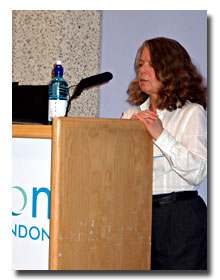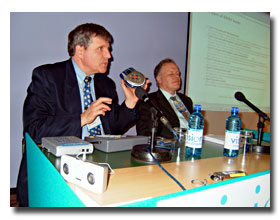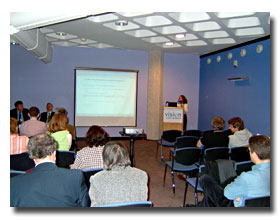Reading the DAISY Way
the International Standard for"A better way to read"
DINF Reading the DAISY Way (VISION2005 April 04 2005)
Date: 2005 April 04
Venue: VISION2005 The, Queen Elizabeth II Conference Center (London, UK)



An hour DAISY introductory session was held by DAISY Consortium member association representatives, Lynn Leith as a leading lecturer (CNIB, Canada) with George Kerscher(RFB&D,USA). It showed very well what DAISY can do and what DAISY is aiming for in a very simple manner.
Reading is for Life
Vision loss negatively impacts a persons ability to access information in a meaningful and useful manner. Braille, although extremely limited in availability, does provide this, but most people lose their vision later in life when learning braille is difficult or impossible, and many low vision children are not taught to read braille.
For decades the audio cassette (and before that the vinyl record) were the only way in which the majority of individuals with vision loss could access information. But for anything other than reading a book from one end to the other, these analogue formats were simply inadequate.
Mobility training is perhaps one of the first things someone with vision loss seeks, however, once this is completed, there is no ongoing need for direction in mobility or orientation. Reading, access to information and learning however, are an ongoing part of life. Without these, a person is severely restricted in education, career and lifelong, daily learning.
Overview: Exactly What is DAISY?
...an Acronym
DAISY is an acronym for
- Digital
- Accessible
- Information
- SYstem
The original concept for DAISY was born from the need for accessible audio that could be used by individuals unable to read print, as easily and efficiently as a sighted person uses a print book.
At its inception in the early 1990's, the "A" in "DAISY" represented the word "Audio". Much has happened since then, taking DAISY far beyond simple digital audio, and making DAISY truly "a Better Way to Read".
...an International Consortium
The DAISY Consortium is made up of 12 Full Member and 51 Associate Member organizations, and 23 Friends from around the globe, each committed to information access for everyone, and, adopting and implementing the DAISY Standard.
...an Open Non-Proprietary International Standard
The DAISY Consortium works closely with the World Wide Web Consortium (W3C), which is the standards setting body for the Internet.
The DAISY Standard, wherever possible, is based on, and is an application of existing standards, including
- XHTML
- XML
- Synchronized Multimedia Integration Language (SMIL)
It is SMIL which provides the multimedia support for DAISY; it is SMIL that links the elements of the book and which ultimately facilitates navigation, making DAISY "a Better Way to Read". It's the glue that holds it all together.
What Makes a Book a DAISY Book?
A DAISY Book is:
Digital (D)
The combination of digital files that comprise a DAISY book must conform to the recommended and commonly implemented standard, DAISY 2.02, or, alternatively, the more recent DAISY/NISO standard.
Reading in the analogue domain was linear and excessively inefficient. A DAISY book allows the reader to move through the book and to specific points within the book quickly and easily. This is called "navigating" a book.
Accessible (A)
DAISY was designed to be accessible, from the bottom up. At a very early point in the development of the DAISY standard, talking book readers from many countries were consulted regarding their reading requirements and their vision of a fully accessible audio book. It was very clear that analogue recordings did not meet their reading and information needs. Access to points within the books, awkwardness of the cassette medium, sound quality plus numerous other issues made it obvious that producers of talking books had to begin the move to a digital platform. However, a digitally produced talking book in and of itself would not resolve all of the issues, particularly the issues of accessibility and navigation from point to point within the book. During the development process it was determined that for DAISY to be a truly international standard it must go even beyond accessible "audio" and facilitate the production of multiple accessible formats, including braille.
Information (I)
"In the Information Age, access to information is a fundamental human right." from George Kerscher's presentation to the United Nations, Bangkok 2002
Between 3% and 5% of the published print materials in the world are published in an accessible format each year. A public library with 95% of its collection made up of books with their pages glued together would not be much of a library. This however, is equivalent to the way it is for those unable to read standard print.
SYstem (SY)
DAISY, because it is accessible, because it meets the information and reading needs of those who cannot read print, has become an international system based on an internationally adopted and implemented standard.
In short...
DAISY is:
- Accessible for individuals unable to read standard print
- Navigable, allowing the reader to move from heading to heading, page to page, paragraph to paragraph, phrase to phrase and/or potentially word to word
- Navigable, providing direct access to specific points such as pages
A DAISY book is made up of a combination of files including marked up text and audio in any of six combinations. It may be searchable, depending upon the type of DAISY book and the reading system being used. A DAISY book always adheres to the DAISY standards and is "valid" to the standard.
A Variety of DAISY Books
There are six types of DAISY books as defined and described in the DAISY Structure Guidelines. Of the six, four of the types offer improved access and human voice or synthetic speech delivery through links between the digital audio sound files and the marked up text files. It is these links that give the reader access to the structure of the book; these links are the key to a DAISY DTB.
Six types of DAISY books
- Type 1: Full audio with Title element only:This is a DTB without navigable structure. Only the title of the DTB is available as text - the actual content is presented as linear audio only. Direct access to points within the DTB is not possible.
- Type 2: Full audio with Navigation Center (NCC or NCX) only:This is a DTB with structure. The structure is two-dimensional, providing both sequential and hierarchical navigation. In many cases, the structure in this type of Daisy DTB resembles the table of contents of its print source. Some of these productions provide page navigation.
- Type 3: Full audio with Navigation Center and partial text:This is a DTB with structure as described above, as well as some additional text. The additional text components may occur where keyword searching and direct access to the text would be beneficial, e.g., index, glossary, etc. The audio and existing text components are synchronized.
- Type 4: Full audio and full text:This is a DTB with structure and complete text and audio. The audio and full text are synchronized. This type of production may be used to generate braille.
- Type 5: Full text and some audio:This is a DTB with structure, complete text, and limited audio. This type of DTB could be used for a dictionary where only pronunciations are provided in audio form. As in the previous categories, the audio and text are linked.
- Type 6: Text and no audio:This is a DTB containing a Navigation Center and marked up/structured electronic text only. No audio is present. This file may be used for the production of braille.
Is It a Book or a Multimedia Reading Experience?
- Publicly available print books came into being with the Guttenburg press approximately 500 years ago.
- A traditional talking book (1930's) is an analogue representation of a print publication.
- A DAISY Digital Talking Book (DTB) is a multimedia representation or replication of a print publication.
Braille was the first breakthrough providing access to print books for those who were blind. DAISY is the second, and, at this point, the ultimate accessible standard for accessible reading materials.
DAISY DTB's provide synchronization of the following media types:
- Audio - human voice or synthesized speech narration of the printed word
- Text - the electronic (XML-based) text of the publication
- Images
- Video (under development)
Central concepts: structure and navigation
Structure
Structure is at a minimum two-dimensional, representing the sequential and hierarchical structure of the publication.
Navigation
How do you use a reference book, a gardening book, a cookery book...
From cover to cover, or do you go to a specific point in the book to read the portion that is of interest or will provide you with the information you require? Navigation in a DAISY Digital Talking Book is defined in two ways, global navigation and local navigation.
Global Navigation
...is movement to a specific point or portion of a book, for example a chapter, part, page, or, the index.
Local Navigation
... is movement within a single text element such as a list or table, or within a narrow range of text elements such as a group of words, sentences or paragraphs. The analogy to reading a print book would be "skimming".
The Vision, Mission and Goals of the DAISY Consortium
Vision
Our vision is that all published information, at time of release to the general population, be available in an accessible, highly functional, feature rich format and at no greater cost, to persons with print disabilities.
Mission
Our mission is to develop, integrate and promote international DAISY standards, technologies and implementation strategies to enable global access by people with print disabilities to information provided by mainstream publishers, governments, and libraries in a way which will also be of benefit to the wider community.
The DAISY Consortium works toward worldwide availability of publications in DAISY format, wherever print or electronic content is produced.
The Consortium pays special attention to and encourages the use of the DAISY standards in developing countries.
Goals
- Standards
- Tools
- Advocacy, Awareness, and Worldwide Implementation
- International Library, Lending, and Exchange
- Developing countries
- Communication
One Button to Press: "...a Better Way to Read
"Navigation", "structure", "meaningful and useful way to access information", these and other terms which describe the enriched DAISY reading experience all seem to be geared toward advanced or educational reading requirements. However, DAISY Digital Talking Books and reading systems accommodate both the advanced reader's needs and the reading needs of those who need a very, very simple way to read. Audio tape books provided by libraries "of and or for the blind" needed to be changed from side to side, controls needed to be changed as sides or tracks ended, and there were always multiple tapes to be removed or inserted into the players. More than 95% of all DAISY books fit onto a single CD (the current distribution medium for most DAISY books). A senior person who has very limited technical skills and/or restricted manual dexterity, can play a DAISY book by pressing a single button. That same button will stop the playback. There are no tapes to change or toggle switches to press. Some of the current DAISY reading systems have a "sleep" function which can be set, so that playback will stop after a set time period. If the reader falls asleep, the DAISY player will stop after the preset period. All DAISY reading systems will retain in memory the last point at which a book was played, and will retain this information for multiple books. Reading could not be easier.
Functionality to Meet All Needs
On the other side of "One Button to Press", some of the more advanced functions of DAISY Digital Talking Books include: bookmarking, word searching, "go to page functions", and speed up and slow down of audio with no distortion of the sound.
The Potential DAISY "Audience"
All Ages, All purposes
- Pre-school
- Elementary and Secondary School
- Post Secondary
- Career, start to finish
- Retirement
Those Who Cannot Use Standard Print
- Vision loss
- Cognitive disabilities
- Physical disabilities which limit ones ability to hold a print book
DAISY Questions
- Where can people get DAISY Digital Talking Books?
- Where can we get players and how much do they cost?
On an Equal Playing Field
One of the goals of the DAISY Consortium is to move the DAISY Standard into the mainstream. The first steps have been taken. When mainstream publishers begin to make their books available in DAISY format, the percentage of accessible reading materials will begin to grow, we will be on our way to an equal playing field. Information will be accessible.
A great deal of information about DAISY Digital Talking books, the DAISY Standard, and DAISY reading systems (hardware and software players) is available at the DAISY Web site.
Read More www.daisy.org
